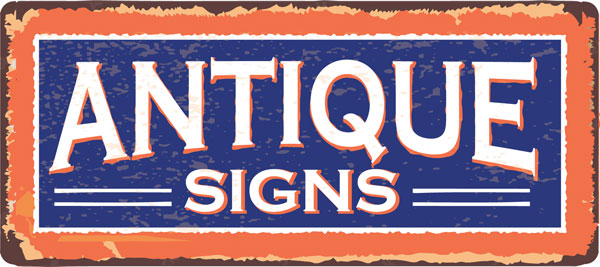Replicas, reproductions and fakes
Collecting vintage porcelain enamel signs is a fun and rewarding hobby, but it’s not for the faint-hearted nor can it be taken at face value.
If you’re looking to start your own vintage sign collection, especially as an investor, it’s important to be aware of the challenges and pitfalls, as any collectible can be falsified.
Authenticity
The name of the game in collecting is authenticity. Vintage signs are valuable not because of their pristine condition, but because they are the genuine article – a practical, functional work of art that has served its time.

For many, they represent the nostalgia of different eras. Whether it’s the shadow of the industrial revolution, a splash of colour in time of war or a slice of the golden age of Americana, porcelain enamel signs can be art, advertising and a sign of their times.
So, it’s important to understand that their value comes from being the real deal, rather than looking their best. Good condition is desirable, but not at the expense of authenticity. This is particularly relevant when it comes to replicas and restorations.
Replicas and restorations
There is an honest market for vintage replicas and sign restoration, but it’s not for the buyer who wants a good investment.
If you’re after an excellent reproduction of a classic sign to decorate your home or workplace, by all means – a reproduction is a great choice, especially for the harder-to-get signs. But it won’t carry the weight – or the price – of an authentic sign.

The same goes for restorations.
You can have a professional touch up your weathered or beaten-up signs, but in the eyes of most collectors they will go down in value rather than up – they will have lost their authenticity despite their improved appearance.
So as an investor, with the expectation that your purchase will increase in value over time, you’ll want to avoid restorations and reproductions outside of personal use.
Avoiding fakes
The vintage sign collection market can be very lucrative, with classics often auctioned off for tens of thousands of dollars. There is however a shadow on the world of collecting.
Quite simply, a thriving market attracts a wide variety of frauds, scammers and counterfeiters.
Navigating the sea of lies and trickery in search of the genuine article is a big part of vintage collecting, and you’ll need to know what you’re up against.
Here’s a few tips to help you avoid unscrupulous sellers and the blow to your pride at having purchased a fake.
Stick to trusted sellers
It’s never been easier to shop for vintage signs. Between the convenience of online markets and the rising popularity of classic enamel signage, there’s no shortage of sellers. But the easier it is to buy one, the easier it is to be scammed.
Because of the sheer number of replicas and restorations on the market, not to mention brazen counterfeiters, purchasing from an unverified stranger in an online marketplace is a particularly risky proposition.
Unless you know what you’re doing, it’s best to stick with reputable and reliable sellers and well-known collectors. They’ll provide a guarantee of authenticity and offer your money back in case the sign turns out to be fake.
Spotting fakes
The vintage sign market, like any collectibles market, is a mix of fakes, mistakes and the genuine article.
It’s important to be able to discern an authentic vintage sign if you want to avoid any costly regrets, and to make a great ‘find’ of your own. Unfortunately, that’s easier said than done, especially for someone new to the hobby.

Even a trained eye can struggle to recognise a well-made fake. There are many things to know – forgery techniques and tells, manufacturing styles, even when certain fonts were first introduced.
The important thing for any newcomer is to do research around what you’re looking to purchase.
Try to find pictures of a genuine, authenticated version of your sign for comparison, look into the style and other designs of the manufacturer, or seek professional advice.
You can sometimes spot cheaper fakes yourself by recognising clear giveaways such as:
- modern fonts
- blurry text and images
- misplaced or absent mounting holes
- lack of weathering or ageing
- a smooth finish instead of layered enamel
- signs that are the wrong colour, size or shape.
It’s safe to assume that if a bargain looks too good to be true, then it usually is. Your main solution to the problem of collecting these days is constant vigilance.

